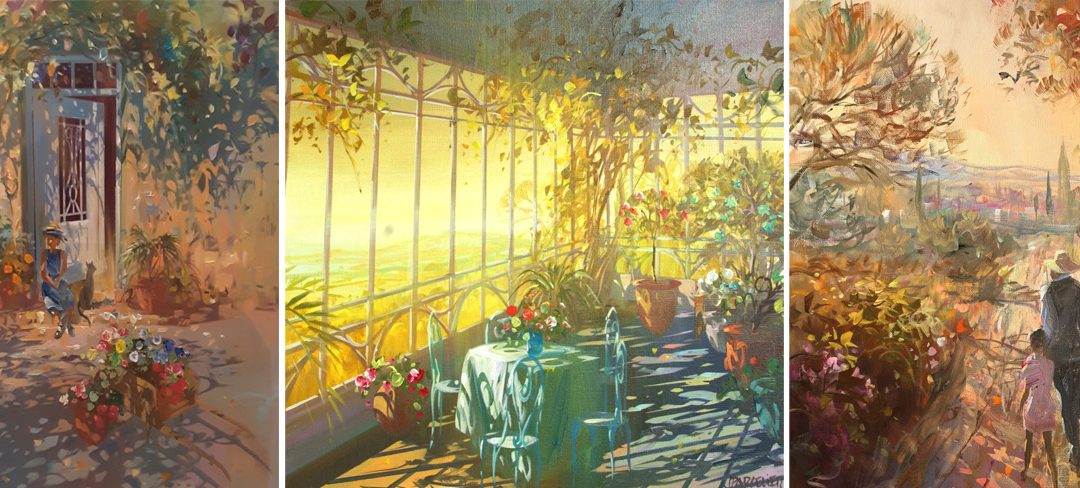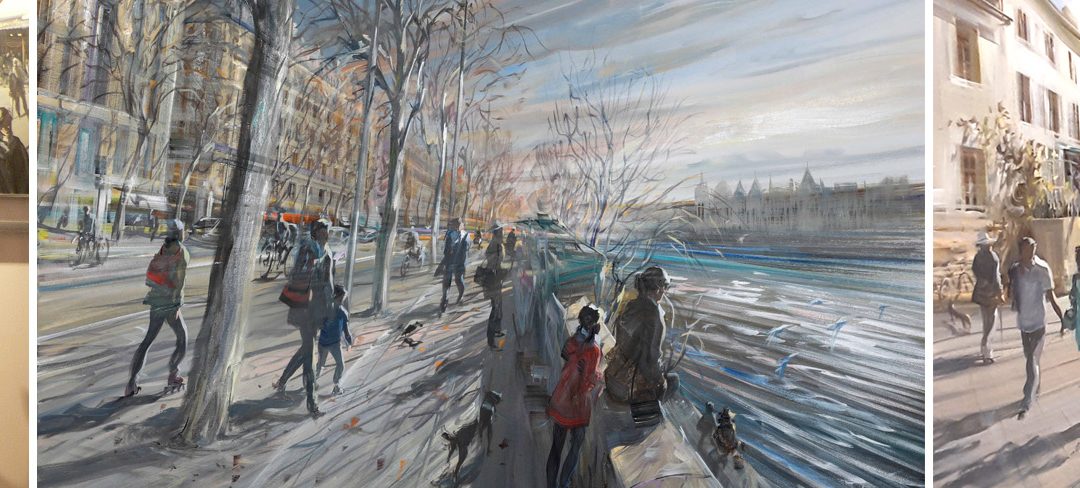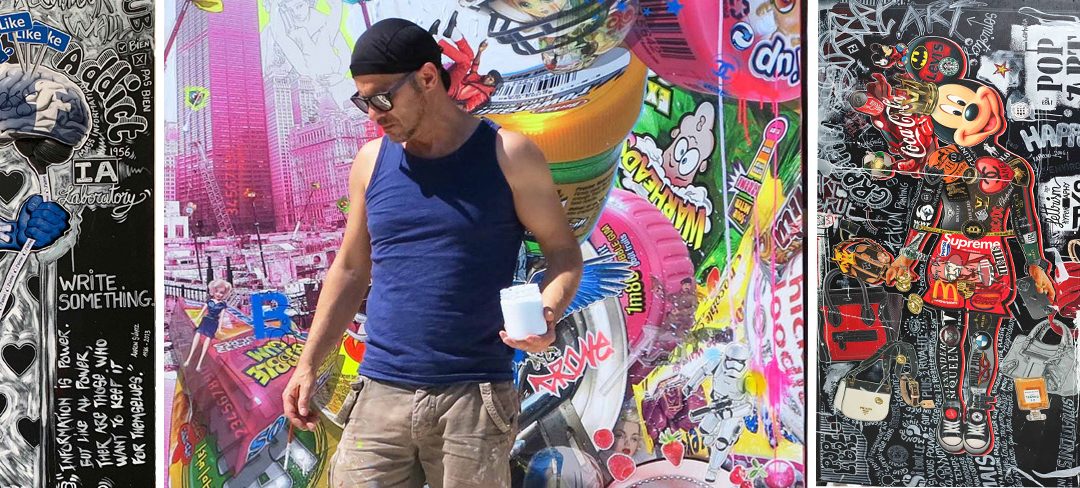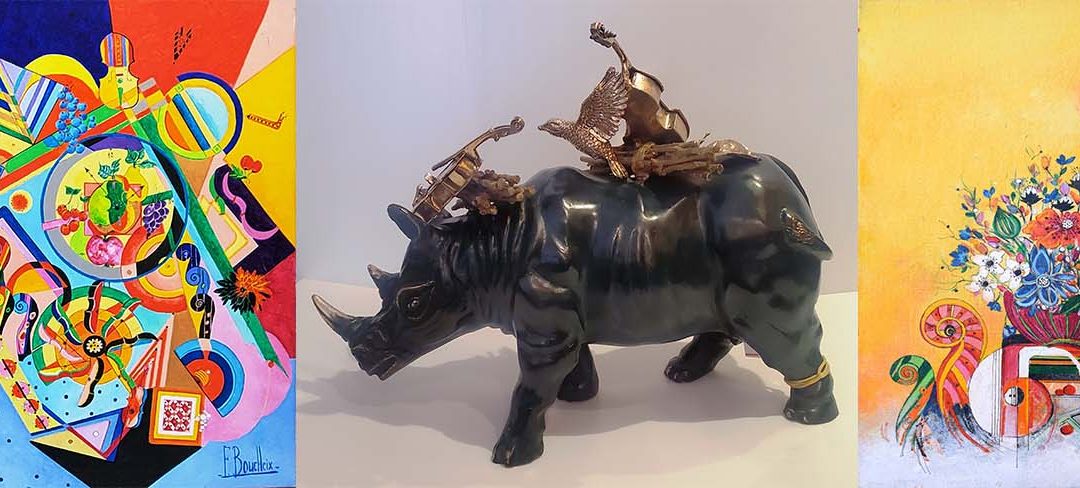
Aug 15, 2016
PARCELIER Laurent was born in 1962 in Auvergne.
After studying Applied Arts Duperré in Paris, he started in the comic. He published 8 albums at Casterman.
Meanwhile he began to devote himself to painting. It exclusively since 1996. Since that date, after several shows and exhibitions he exhibited in several galleries in France and the USA.
If we had two words, not one more set for the work of Laurent PARCELIER, it would be poetry and light. Which might be added, luxury, calm and voluptuousness, love of nature, quiet places and warm family atmosphere.
Poet of light, the poet is assured. Blink eyes slightly, place in front of one of his paintings and watch it at your leisure, you will only see sparks of light everywhere.
Laurent PARCELIER gives the impression of living in eternal holiday, between Provence and Luberon.
Happy and contemplative, flowing peaceful days with family in a beautiful house, basking in the sun of the south, nestled in a village clinging to the hillside, with the only horizon, the sky, the sea, a flowery plain, wooded mountains, offering bahous bald head to the caress of the day.
Impressionism :
As part of the largest movement of traditional French impressionist painting, and more specifically, the work of Parcelier is not less remarkable and very personal.
The visitor’s eye is first attracted by the graphic writing that comes from his experience in the world of comics. It was then struck by the meticulous and rigorous construction of his paintings. There is indeed a kind of spine that allows the color, broadcast by a multitude of light touches, not to get lost in a chaotic abstraction.
The works of Laurent Parcelier are part of many private collections throughout the world, and are well known to art lovers from France and Europe.

Aug 15, 2016
Born in 1962 in the Puy-de-Dôme, Kerdalo lived a childhood of Fine Arts. He spends his time drawing, coloring, painting, cutting, shaping.
Graduated from the School of Applied Arts in Paris, he started in the comic and Parallel to painting.
Since 1996, he devoted himself exclusively to painting.
Kerdalo offers us a rare and amazing writing that combines monochrome colors, to give us a full oil painting of life and lights …
Indeed, the work of Kerdalo not belong to any known phenomenon, it may be appropriate for him to invent the term modern impressionism to describe this new pictorial approach.
Animated with a rare gift for the treatment of light, Kerdalo register as the heir of the great Impressionists. With an experience of three decades, he has invented a truly innovative painting without ever leaving intoxicated by his success.
Kerdalo continues to use the most noble and most demanding because painted in oil, with a fluid touch that has no need of subterfuge thickness to be fully expressed.
In true ethnographer, Kerdalo tells the city by offering a pictorial evocation that fits perfectly in the twenty-first century. It is undoubtedly in the tradition of painters who believe that painting is a form of expression that can adapt to the times.
And as there is no lack of audacity, or ideas, the result is a measure of his immense talent. Present in many prestigious galleries in France, it is now moving into foreign galleries, its reputation is therefore well established in his country.
Kerdalo is a painter as one might think “hyper-realistic”, but his work is more personal. Marked by respect and the search for movement, he developed his own style. His subjects, mostly urban, are perfect to capture the moment as a still picture freezing animation of our cities.

Aug 11, 2016
Cintract David was born in 1970.
Halfway between Warhol and Lichtenstein, the artist projects his vision of consumer society on all media : paintings, dolls or mannequins.
While paying tribute to the great artists Pop, David Cintract has stood out thanks to his strong personality, becoming a key figure in the movement that he founded: “The Pop free.”
David Cintract has a fascination for the exuberant sculpture and storage works so “Aladdin’s cave”.
Inspired by current events and social issues, his work carries with it the ambiguity of a quirky, childlike artistic universe, the tinted optimism tragedy.
Gaiety of colors and patterns, sparkle and communicative joy, but also depth of questions and symbols, such is the David Cintract trademark of refusing ease and laying discrete connections between very poetic forces and darker impulses.
Using techniques as diverse as oil, photo, inclusion or digigraphie, it develops on all media (paintings, models, cars …) several themes at the heart of our postmodern society:
-L’homme Face a frantic and frivolous consumption
-The Place of the fantasies and erotic adult games
-The Loss of our part of childhood in a society that no longer believes in dreams
David Cintract sets worldwide and, thanks to its universal artistic language, nourishes deep exchanges with audiences from all backgrounds and all cultures.
Interview by Mr DAVID CINTRACT LIVE:
“My art reigns in me, but does not rule me”
DJ image and matter, David Cintract is defined as a visual artist and existential touch.
Multisensory, it passes with disconcerting ease of traditional painting techniques with modern technologies such as digigraphie, photography, the inclusion of other products / toys …
Through its mannequins that “dandyse” its Mutantoy’s Candy Box and he makes of individuality in the manufactured and deposited his poetry in the series of objects.
Q: “Is being an artist is obvious to you”?
Art and philosophy are to me the best way to aesthetize my existence. With these two means of expression and reflection, I was able to optimize my tragic optimism and reverse the general neuroticism contemporary works. My wish is to deal with company or topical subjects more or less serious, and to attempt a democratic and positive transcription. For me it is a fun way to play with images and frivolous objects that recall childhood with filigree the finding of a report obsession we have with frivolous consumption, fueled by advertising constantly renewed. This work brings me also to wonder if happiness would not exhausted the pleasure of consumption

Jun 4, 2014
François Boucheix was born January 7, 1940 to Montcheneix, a small village at the foot of the Monts d’Auvergne. He began drawing very young. Fatherless at 15, he has to learn a different profession of his artistic aspirations. Malgrè the hard work of the day, he held the evening and part of his nights to paint, and his days of freedom.
At 17, supervisor at Marist in Riom, he as a neighbor room the painter Jean de Rocca Serra, Rome Prize and former professor at the School of Fine Arts in Florence, who taught him the painting for a year.
He made his first exhibition in February 1960 in Tunisia, then in Auvergne province in particular and in the south of France. Four years in Chamonix, where he reads an advertisement in a national newspaper, the gallery seeks Sèvres painters. It responds to the announcement by sending photographs, and shortly after he learns he is retained.
It manifests itself in Paris in 1963 at a major exhibition at the Galerie de Sèvres where he met Bernard Bellaïche. From 1966 to 1972 he regularly exhibits in this gallery notably Lebasque, Othon Friez, Dignimont, Crau Salaboudet Madeleine Luka, Marie Laurencin and the paintings of Salvador Dali and Foujita.
François Boucheix offers a surreal view of the world with total freedom of inventive richness and wonder gift that keeps intact his fidelity to his roots and his land Auvergne. [Not neutral]
Bernard Bellaïche he meets Salvador Dali and that day everything changed. Dali tell him “your painting is good … besides she likes to Gala. ”
This is a result of a famous exhibition at the Sèvres gallery in Paris “Dali to Boucheix” with paintings by Meissonier he decides it will be a surrealist painter of dreams and happiness and not a sad surreal .
He also met with the Sèvres gallery of Yasmine Ouezan, friend of the arts at all Paris of that time, the meeting will pass 30 years of friendship.

Jun 3, 2014
Peter Klasen is born in Lubeck, Germany in 1935.
Lives and works in France.
From 1956 to 1959, Peter Klasen studied at the School of Fine Arts in Berlin. In 1959, winner of the mécennat of German industry, he obtained a scholarship and moved to Paris.
Peter Klasen is in the 60, a founder of the artistic movement called New figuration or narrative figuration. He develops a personal visual language, exploring and reinterpreting the signs of our urban environment, and more generally in our society.
Industrial theme profoundly marked his work. We thus find in the paintings of Peter Klasen, items such as pressure gauges, gear plate public works, metal locks, truck tarpaulins .. Also present logos, numbers and pictures from magazines or posters .
Painter of the urban concrete and metal, Peter Klasen explores the depths and vertigo of a dehumanized society. His works are present in more than 60 museums and public collections worldwide.
His works have been the subject of numerous monographs.
“Painting frees me from my anxieties”
What motivates you to paint ?? An engine that is up and running all alone, like a Volkswagen. Well, it’s not really a good example, right now, with the problems of the brand …
Photography. Photo feeds my future work. I leave my travels and I’m sorting the workshop. From this material, I develop new themes. Photographing the reality is not reduced but the sublime. This is an investigation of reality through the lens. The close-up limits our field of vision and focus our attention.
Language. I developed an antibody language that resists permanent aggression exerted on me the outside world. This is the summary of my life. The strength necessary to meet the individual and collective threat that we face.
Anguish. There is a common thread in all my work: loneliness, anxiety ?; this is what I feel in this society that ultimately makes us sick. This is as a painter, with my images, I try to free myself, to find answers.
Thought. It is three-dimensional: painter, photographer and sculptor. People know the painter and photographer but they often forget the sculptor.
New York. The discovery of a mythical place and the same time the rediscovery of a city that cinema had already perfectly told me.
Walls. The places on the fringes of our cities, underground, scrap, landfill yards, the hidden faces of our industrial world exert a strange fascination for me.
Wife. Always eroticized. It does not escape its reassuring aesthetic that brings us back to life. Through fragments of the female body, I invite the viewer to do the job.
Contemporary art. I think of the greater good, I accompany. This is more exciting than ever. Above the Street Art, a reaction to what the city offers us. Our tables are too small.
If you had not been a painter ?? Musician. My father was a musician in his spare time. He played the violin Brahms, Bach, Mahler …
Page 10 of 11« First«...7891011»







